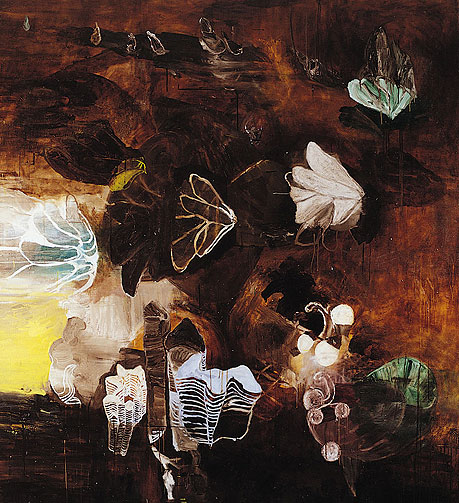COTTON, Shane;
Stack
1991
Oil on canvas
1830 x 1670mm

The following two texts were written for Te Huringa/Turning Points and reflect the curatorial approach taken for that exhibition.
Peter Shaw
Shane Cotton was born at Whakatiki Upper Hutt. After completing a Bachelor of Fine Arts at Canterbury University in 1988 he steadily gained recognition as a painter in Australasia. He held the Frances Hodgkins Fellowship at the University of Otago in 1998. In 2003, a large-scale exhibition at the City Gallery, Wellington, toured the major public art galleries in New Zealand.
This is an example of what has come to be known as Cotton’s ‘biomorphic’ period, in which he explored the aesthetic possibilities of living organisms. Preceding the more obviously political paintings that he made after 1992, they show images of cells, threads of chromosomes and biological processes floating against murky backgrounds. There are also references to aspects of Māori mythology, something Cotton at first found difficult to incorporate into his work as such issues had not been explored as part of his art school training. A hint of this interest can be seen in the group of interlinked koru submerged in the surrounding dark, watery environment. Light is subtly filtered through, adding texture and atmosphere to the painting.
Jo Diamond
It is quite a liberty to take an artist’s early work and liken it to current issues about genome projects in existence today. These join earlier, much-debated attempts to determine our Māori genetic origins. In one respect, they amount to a further colonisation of our identity in terms of a Western scientific set of biological maps and definitions. A counter view reminds us that, in Māori whakapapa, genes and genealogy are inextricably linked. Indeed, they have equal status as ‘taonga’. Shane Cotton’s theme of chromosomal formations reminds me of this. His later themes concerning Māori identity and recent history are closely connected with his early scientific/artistic exploration.
Today, thanks to political actions by numerous Māori scientists and activists, such a connection is a given. Our genes, like those of other indigenous groups, should not be stolen away for scientific research. Stack, with its beautiful stamen and petal forms based on microscope observations, may be free of overtly political intentions but Cotton’s obvious interest in microbiology within this painting is a portent for his later and much more extensive interest in Māori social issues. At this moment, early in his career as a painter, a seemingly innocent interest in forms beyond the naked eye suffices. Those forms stand seed-like, awaiting the fertile ground Cotton leads us towards in his later, more overtly political paintings.
Exhibition History
Shane Cotton: Mai konei ki tēnei wā | From Here to Now, Whirinaki Whare Taonga, Whakatiki Upper Hutt, 28 September 2024 to 2 February 2025
Te Huringa/Turning Points: Pākehā Colonisation and Māori Empowerment, Sarjeant Gallery Te Whare o Rehua, Whanganui, 8 April to 16 July 2006 (toured)
Shadow of Style: Eight New Artists, curated by Gregory Burke and Robert Leonard, Wellington City Art Gallery (later City Gallery Wellington Te Whare Toi), 8 August to 4 October 1992 (toured)
Provenance
1993–
Fletcher Trust Collection, purchased October 1993
